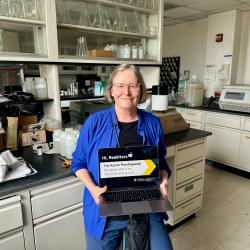Help Revolutionize Classroom Learning and Research with 3-D Printed Fossils, Maps and Rocks
UMD crowdfunding campaign supports purchasing a 3-D scanner, 3-D printer and printing supplies for the Department of Geology
Next semester, the fragile fossils and rocks once displayed in University of Maryland geology classes could be replaced by plastic. Using 3-D scanning and printing technology, students could receive plastic copies of objects they wouldn’t have been allowed to hold before, such as delicate fossils squirreled away in museums and teaching collections around the world.
“Three-dimensional models are powerful teaching tools—they’re nearly indestructible, will last longer for students to use in class and can be created without risking damage to the originals,” says Nick Schmerr, assistant professor of geology at UMD.
Schmerr and his colleagues Laurent Montési and Vedran Lekic are spearheading a crowdfunding campaign to raise $7,000, which will allow them to purchase a 3-D scanner, 3-D printer and printing supplies for the university’s geology department. The campaign will be run through a new crowdfunding program at the university called Launch UMD.
The faculty members believe three-dimensional scanning and printing of rocks, fossils and geologic data will revolutionize teaching and research in the department. They envision 3-D printing many different types of geology objects:
-
- Dinosaur skeletons: Dinosaur fossils are gigantic, and they can weigh several tons, making simple tasks like fitting different pieces together nearly impossible. By printing lightweight plastic fossils at 1/10 the size, students can engineer fully working limbs to create, in effect, a fully accurate robotic dinosaur leg or arm, and eventually, a complete dinosaur.
- Touchable topography: Students can develop a sense of scale and visualize the connection between topography on a map and topography in the real world through 3-D topographical models that combine features like underground rock layers and the resulting surface patterns.
- Rocks: The microscopic, intricate pore networks and exterior shape of rocks can be examined in scaled up 3-D printed models.
- Crystal models: Representation of crystal shapes of minerals—such as a hexahedron, rhombohedron, octahedron and dodecahedron—are common in geology classrooms. 3-D printed tactile models will allow students to see and “feel” the symmetry of these shapes.
The rapid proliferation of 3-D printing technology began in the early 2000s, but the high price of printers put them out of reach for most academic researchers and hobbyists until recently. By placing an original fossil or rock sample on a 3-D scanner, one can make a digitized copy of the object. Alternatively, a 3-D shape can be designed completely within the computer. Next, the pattern is input into a 3-D printer that uses spools of plastic filament, which come in a kaleidoscope of colors and types, including a dissolvable filament. The printer melts and extrudes these plastics in layers at temperatures topping 400 degrees Fahrenheit. The plastic models can be printed in a variety of sizes, ranging up to 12 inches.
When the UMD faculty members scan geological objects from the university’s collections or create their own objects from digital data, they plan to make the 3-D specimen patterns available to the public by posting them online.
“Three-dimensional printing will allow the University of Maryland to make geological structures that are replicable, malleable and easier for students to understand,” added Montési.
The team’s crowdfunding campaign runs through November 22. You can support the team at any time by visiting http://ter.ps/geo3d.
Crowfunding page
Nicholas Schmerr homepage
Laurent Montési homepage
Vedran Lekic homepage
University of Maryland
College of Computer, Mathematical, and Natural Sciences
2300 Symons Hall, College Park, Md. 20742
www.cmns.umd.edu
@UMDscience
About the College of Computer, Mathematical, and Natural Sciences
The College of Computer, Mathematical, and Natural Sciences at the University of Maryland educates more than 7,000 future scientific leaders in its undergraduate and graduate programs each year. The college's 10 departments and more than a dozen interdisciplinary research centers foster scientific discovery with annual sponsored research funding exceeding $150 million.







